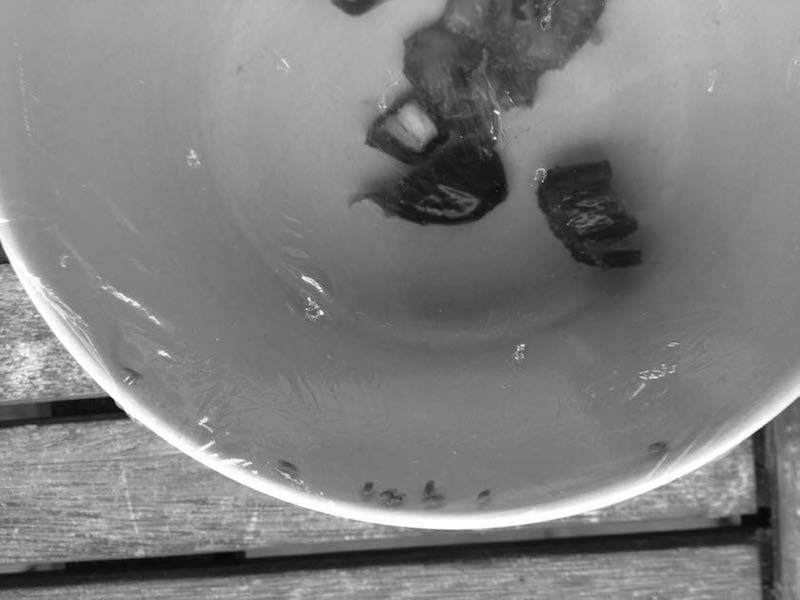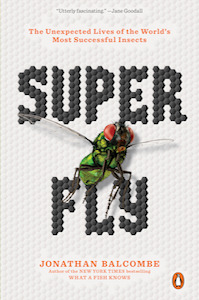
How Science Has Revealed the Inner Consciousness of Invertebrates
Jonathan Balcombe Considers the Captivating Mental Lives of Insects
A Bowl of Rotting Peaches
Before getting into the science, let me share a personal experience of the sort that may give one pause before concluding, as I suspect most do, that insects are incapable of having conscious experiences. While visiting a friend’s country home in southern Ontario one summer, I noticed a small, white ceramic bowl perched on a kitchen countertop. Nothing unusual about that, I thought, until I peered inside. There I found a most curious sight.
The bowl contained several chunks of peach looking well past the threshold of human edibility, and about 50 fruit flies. The bowl was sealed by a film of plastic wrap stretched taut around the rim. Most of the flies were standing around, like guests sipping wine at a cocktail party. Some strolled casually over the fermenting fruit, which was speckled white around the edges with mold. A few others stood or walked across their “glass” ceiling in that gravity-defying way that flies do.
I gazed in wonderment at this strange domestic scene. There is nothing unusual about seeing fruit flies in kitchens. But how in god’s name did these end up inside that layer of plastic? Had my friend Celia sneaked up on the bowl with plastic wrap in hand and pounced on it? Such is the wariness and speed of flies that all but a few would surely have taken wing and escaped before the veil came down over them. Were the flies already incubating on the peaches when the plastic ceiling was installed? That couldn’t be it, for there were no telltale pupal husks in the bowl.
When she returned from an errand, I asked Celia about the peach bowl, and the riddle was solved. It was a flytrap. The construction was simple enough: place pieces of overripe peach in bowl, seal with plastic wrap, poke a dozen or so tiny holes in the plastic with the tip of a sharp knife, wait a few hours, and voilà: trapped flies.
What?
If you’re like me, you’re trying to visualize a fruit fly squeezing through a tiny slit in that plastic layer. For one thing, how do they find the holes? That’s a matter of what most folks might describe as the alluring aroma of fetid peach seeping through a crack in the wall, and what scientists would call a chemical gradient. The perceptive flies follow the irresistible scent trail to its source. But how do they get inside? How does a little fly squeeze through the slit? I’ll come back to that in a moment. The fact is, they get inside, and they have their way with the peach, taking their fill of the succulent liquor and, given enough time, mating and laying eggs.
“It works like a lobster trap,” Celia told me. “They can get inside, but they struggle to find their way out.”
I was surprised to find the trap in its same spot the next morning, with the same mold-flecked peach looking like the aftermath of a fly orgy. But there were not more flies in the bowl; there were fewer. I grabbed my binoculars (as a birder, I never travel without them, and when you turn them around they make an effective magnifying glass) and came in for a closer look.
What I witnessed astonished me. A fly trotted across the plastic ceiling, found one of the slits in the plastic, and proceeded to make its exit. The tiny insect used its two forelegs to pry apart the plastic, squeezed its head through the fissure, then worked away with its remaining four legs to squeeze its plump, peach-filled torso free of the barrier. The operation required a considerable, coordinated effort and took a minute or more to complete. Once out, the fly paused momentarily, then flew off.
 These fruit flies found their way through tiny holes in the plastic wrap stretched over a bowl of fruit and are preparing to find their way out.
These fruit flies found their way through tiny holes in the plastic wrap stretched over a bowl of fruit and are preparing to find their way out.
“Celia, you might want to take those flies outside now. These traps work in reverse, and some of your flies are escaping back into the kitchen,” I told her.
What so captivated me about the flytrap incident was not so much the flies’ ability to find their way to the rotting fruit, but the apparent intentionality and determination with which the flies escaped the trap. While it is easy to imagine what drives fruit flies to enter a peach trap, it’s puzzling what drives them to want to leave a luxurious source of food and a breeding site. One can argue that instinct “drove” her in, but was it instinct that “drove” her out? It left me struggling to reconcile what I had just seen with a common assumption that flies are nothing more than robotic automatons, with no experience, no awareness.
As I sit in a busy coffee shop recalling the memory of Celia’s flytrap, I’m watching a poodle mix snuffling around the café, homing in on dropped crumbs that have escaped under padded chairs, and I’m reminded of how much keener another being’s sense of smell can be than mine.
There are other variations of Celia’s simple flytrap. In a short online video, Cornell University entomology professor Brian Lazzaro explains that a funnel placed over a jar of wine or overripe fruit will lure fruit flies in and confound their attempts to exit. I wonder if that design, too, becomes less effective with time.
One can argue that instinct “drove” her in, but was it instinct that “drove” her out?
Marla Sokolowski, a professor of genetics and neurology at the University of Toronto and a former teacher of mine, told me of walking into a grocery store where there were lots of flies and telling the manager how to catch them with a trap like Lazzaro’s, consisting of a funnel placed in a half-empty bottle of beer (or yeast and water). Marla’s daughter, then a preteen, rolled her eyes, embarrassed to have a mom who talks to strangers about flies. When they returned to the store two weeks later, there were noticeably fewer flies and one grateful manager. These traps represent human ingenuity capitalizing on fruit flies’ resourcefulness.
A Blurry Line
When it comes to mental abilities, we tend to hold vertebrate animals in higher regard than animals without backbones. We tend to believe that invertebrates lack any mental life whatsoever. But science has been exposing the frailty of such a belief, and a once bold line drawn between vertebrates and invertebrates has become blurry.
The evidence for consciousness in octopuses and their molluscan kin, for example, is fairly unimpeachable. If you doubt this, I encourage you to read The Soul of an Octopus by Sy Montgomery, or Other Minds by Peter Godfrey-Smith. Octopuses and their close relatives the squids, cuttlefish, and nautiluses (collectively, the cephalopods) have the most complex nervous systems among invertebrates. Octopuses display problem-solving abilities, emotion, play behavior, and unique personalities. They can untie knots, open jars, and gain access to toddler-proof containers. They can learn by watching others, and they are renowned as escape artists. Some experts believe that octopuses were the first creatures on Earth to evolve consciousness, and their evolutionary distance from vertebrates indicates that consciousness has evolved on our planet at least twice.
Moving closer to insects on the tree of life, emerging evidence suggests consciousness might have evolved at least three times. Spiders, for instance, demonstrate intelligent behavior. A notable case is the detour behavior shown by jumping spiders while hunting prey. It was discovered in the 1990s that jumping spiders in the genus Portia will back away from prey in search of a more strategic approach where they are less likely to be detected by the prey. These spiders will also move around an object that blocks the spider’s view of its prey, which demonstrates “object permanence” by the spider. A more recent study by the same research team showed that 16 species of jumping spider (including 10 from genera other than Portia) solved a similar hunting problem that required them to remember a food’s location and to ignore a path that led to a nonfood source.
What about cognition in spiders’ close arthropod cousins, the insects? There are some compelling findings, especially but not exclusively from the social insects.
By taking close-up photographs of a species of paper wasp, scientists ascertained that these colonial insects recognize each other by their distinctive faces. In trials in which choosing an unfamiliar face (digitally doctored by rearranging or removing parts, such as the antennae) was punished and choosing a familiar face was not, they chose the familiar faces.
I love the idea that a wasp recognizes the face of a familiar comrade; maybe they also exchange greetings with their antennae. But my favorite study of cognition by insects involves ants. In 2015, Marie-Claire and Roger Cammaerts from the Université Libre de Bruxelles published the first demonstration of mirror self-recognition (MSR) in an invertebrate. The MSR test was first published in 1970. Chimpanzees were anesthetized then marked in a location such as the forehead where they could see the mark only in their reflection.
When presented with a mirror, the chimpanzees inspected the mark in the mirror and touched or tried to remove it from themselves. This behavior indicates that the chimps recognized that the image was a reflection of themselves, not another chimp, and it became a benchmark test for self-awareness. Until the ant study 45 years later, only great apes, elephants, dolphins, and magpies had passed the MSR test. (In 2018, a fish called the cleaner wrasse joined the list.)
The Cammaertses studied three species of Myrmica ants and found that they behaved differently upon seeing a reflection of themselves in a mirror compared with seeing other colony members through a pane of glass. With the mirror, they behaved uncannily like socialites inspecting themselves before going out for an evening on the town. They rapidly moved their head and antennae to the right and left, touched the mirror, went away from it and stopped, and in some cases groomed their legs and antennae. They also tried to clean off a blue dot placed on the front of their heads, which they otherwise ignored if they could not see themselves or if the blue dot was applied to the back of the head where it was not visible in the mirror. Brown dots, which matched the ants’ body color and were thus camouflaged, likewise were ignored.
Aware of the potential for their study to ruffle feathers (and fur) in the scientific community, the Cammaertses hastened to add that their findings need not necessary imply self-awareness by ants. Isn’t it interesting how readily we acknowledge self-awareness in a mammal but grasp for alternative explanations in an insect because it defies our biased expectations?
A once bold line drawn between vertebrates and invertebrates has become blurry.
In an earlier book (What a Fish Knows), I cited many scientific studies that belie the common prejudice that places fishes below the other vertebrates, especially mammals and birds. It’s a much sterner challenge for insects, and I’m not claiming equality here, but it is a recurring pattern that when we peer closer, animals yield new surprises. It reminds me of the famous words of Louis Leakey when he received news of tool use by chimpanzees from his prodigy Jane Goodall: “Now we must redefine tool, redefine Man, or accept chimpanzees as humans.” What certain insects are now known to be capable of casts serious doubt on a lot of our currently held cultural biases against them.
Ants and other insects also use tools. Funnel ants use bits of leaf, wood, or mud as sponges. Holding the sponge by her mouth, the ant dangles it into a desired source of nourishing liquid (e.g., fruit pulp or the body fluids of prey) before carrying the wetted sponge back to the nest. This technique enables an ant to transport ten times more fluid than she could otherwise carry. A New World ant of arid desert regions surrounds the colonies of competing ants then drops small pebbles and other debris down the entrance holes, giving the marauders more time to forage undisturbed. The use of leaves by leaf-cutter ants on which to grow fungus not only qualifies as tool use but also farming.
Digger wasps use flat pebbles as tools to tamp down the dirt, disguising the entrance to the burrows in which they have buried paralyzed prey to provision their egg once it hatches. One type of assassin bug—a predatory insect with beaklike sucking mouthparts—uses the husk of a sucked-dry termite as bait to lure and catch other termites. The assassin jiggles the dead termite outside the termite nest entrance hole, then grasps a new termite that comes to pull her comrade back into the nest. If the bug successfully grabs its new victim, the previous one is immediately dropped, and the process repeats itself. One bug caught and chugged 31 termites this way before waddling off with a very distended stomach.
Prevailing scientific opinion has been that these are the mindless mechanical workings of instinct bereft of conscious experience. But there are reasons to be cautious in drawing such conclusions. A more in-depth study of tool use by funnel ants conducted in 2017 found flexibility in the ants’ choice of tools for transporting liquids back to the nest. The ants learned to favor superior manmade tools (sponges) for the purpose, and they sometimes modified those tools—breaking the provided sponges into smaller pieces—to enhance their utility.
The strongest challenges to notions that insects cannot think come from honeybees, which have been the subject of a large body of research since Nobel Prize-winning Austrian biologist Karl von Frisch discovered their now-famous “waggle-dance” language in the mid-20th century.
In addition to their mind-blowing facility with multisensory symbolic communication to share the location of distant food sources, bees have accumulated an impressive résumé of mental skills. They can recognize human faces. They understand the concepts of “same” and “different” and can transfer these concepts across different visual modes (shapes to colors) and even across sensory modes (shapes to scents). Bees also seem to understand the concept of zero: when trained (with a sweet reward) to fly to images of fewer dots or symbols (rewarded for picking, say, three dots and not five), they tended to favor a blank image (zero) over an image with a single dot.
Honeybees also appear to have metacognition—that is, knowledge of their own knowledge. Taught to fly to rewarding targets contingent on the target’s size, shape, and color, bees were more likely to opt out of tough discrimination tasks when there was a bitter taste penalty for getting it wrong.
“This suggests that the bees were only taking the test when they were confident of getting it right,” said Dr. Andrew Barron, a biologist at Macquarie University and coauthor of the study.
__________________________________

Excerpted from Super Fly: The Unexpected Lives of the World’s Most Successful Insects. Used with the permission of the publisher, Penguin Books, an imprint of Penguin Publishing Group, a division of Penguin Random House, LLC. Copyright © 2021 by Jonathan Balcombe.
Jonathan Balcombe
Jonathan Balcombe was born in England, and has lived in New Zealand, the United States, and Canada. A biologist with a PhD in ethology, the study of animal behavior, he is the author of four popular science books on the inner lives of animals, as well as over 60 scientific papers and book chapters on animal behavior and animal protection. Formerly Department Chair for Animal Studies with the Humane Society University, and Director of Animal Sentience with The Humane Society Institute for Science and Policy, he also serves as an Associate Editor for the journal Animal Sentience, and he teaches a course in animal sentience for the Viridis Graduate Institute. Jonathan currently lives in southern Ontario, where in his spare time he enjoys biking, baking, birding, Bach, and trying to understand the squirrels in his neighborhood.












